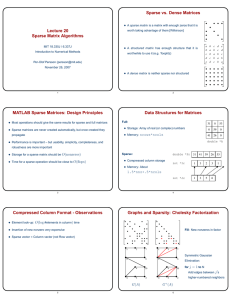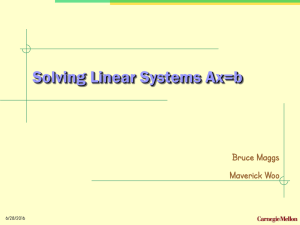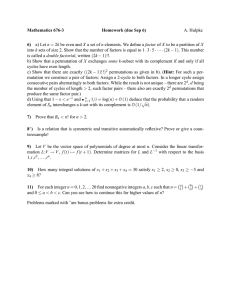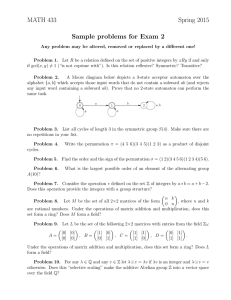Sparse vs. Dense Matrices Lecture 21 Sparse Matrix Algorithms •
advertisement
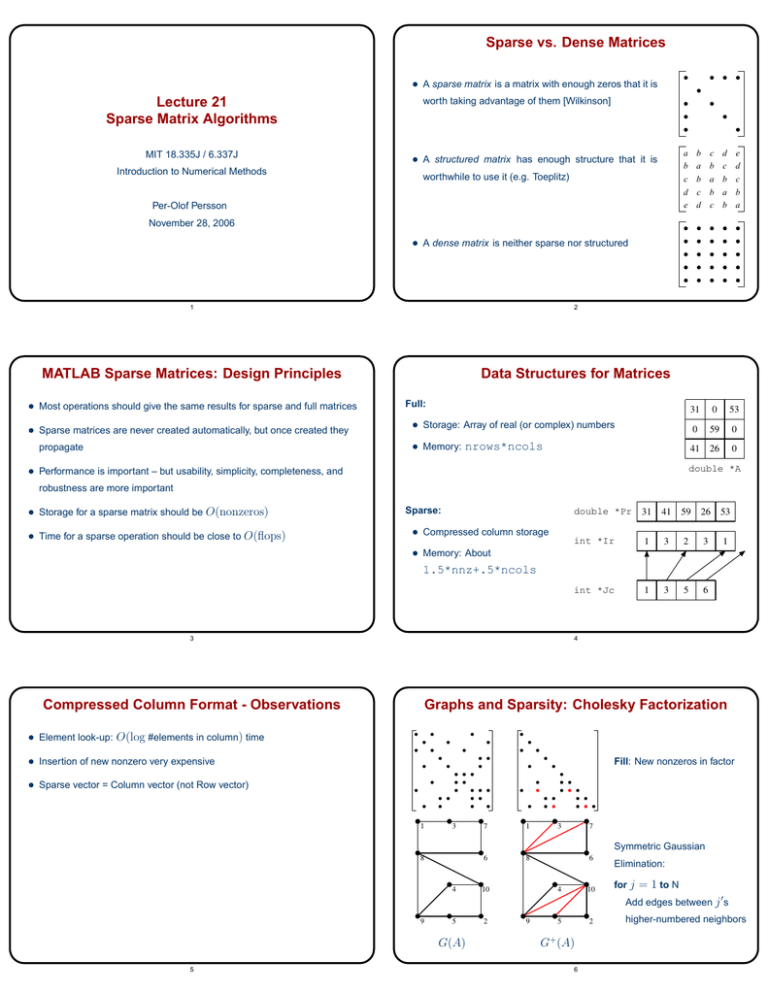
Sparse vs. Dense Matrices • A sparse matrix is a matrix with enough zeros that it is Lecture 21 Sparse Matrix Algorithms MIT 18.335J / 6.337J Introduction to Numerical Methods worth taking advantage of them [Wilkinson] b c d e a b c d b a b c c b a b d c b a a b c d e • A structured matrix has enough structure that it is worthwhile to use it (e.g. Toeplitz) Per-Olof Persson November 28, 2006 • A dense matrix is neither sparse nor structured 1 2 MATLAB Sparse Matrices: Design Principles Data Structures for Matrices • Most operations should give the same results for sparse and full matrices • Sparse matrices are never created automatically, but once created they Full: • Memory: nrows*ncols propagate 31 0 53 0 59 0 41 26 0 • Storage: Array of real (or complex) numbers double *A • Performance is important – but usability, simplicity, completeness, and robustness are more important • Storage for a sparse matrix should be O(nonzeros) • Time for a sparse operation should be close to O(flops) Sparse: • Compressed column storage double *Pr 31 41 59 26 53 int *Ir 1 3 2 3 1 int *Jc 1 3 5 6 • Memory: About 1.5*nnz+.5*ncols 3 4 Compressed Column Format - Observations Graphs and Sparsity: Cholesky Factorization • Element look-up: O(log #elements in column) time • Insertion of new nonzero very expensive Fill: New nonzeros in factor • Sparse vector = Column vector (not Row vector) 1 3 8 4 7 1 6 8 10 3 7 6 4 10 Symmetric Gaussian Elimination: for j = 1 to N Add edges between j � s 9 5 G(A) 5 2 9 5 2 G+ (A) 6 higher-numbered neighbors Permutations of the 2-D Model Problem • 2-D Model Problem: Poisson’s Equation on n × n finite difference grid • Theoretical results for the fill-in: – With any permutation: O(N 3/2 ) fill �(N log N ) fill – With a nested dissection permutation: • A separator in a graph G is a set S of vertices whose removal leaves at least two connected components • Total number of unknowns n2 = N – With natural permutation: Nested Dissection Ordering O(N log N ) fill • A nested dissection ordering for an N -vertex graph G numbers its vertices from 1 to N as follows: – Find a separator S , whose removal leaves connected components T1 , T 2 , . . . , T k – Number the vertices of S from N − |S| + 1 to N – Recursively, number the vertices of each component: T1 from 1 to |T1 |, T2 from |T1 | + 1 to |T1 | + |T2 |, etc – If a component is small enough, number it arbitrarily • It all boils down to finding good separators! 7 8 Heuristic Fill-Reducing Matrix Permutations Heuristic Fill-Reducing Matrix Permutations • Banded orderings (Reverse Cuthill-McKee, Sloan, etc): • Nested dissection: – Try to keep all nonzeros close to the diagonal – Find a separator, number it last, proceed recursively – Theory, practice: Often wins for “long, thin” problems – Theory: Approximately optimal separators =� approximately optimal fill and flop count • Minimum degree: – Eliminate row/col with fewest nonzeros, add fill, repeat – Hard to implement efficiently – current champion is “Approximate – Practice: Often wins for very large problems • The best modern general-purpose orderings are ND/MD hybrids Minimum Degree” [Amestoy, Davis, Duff] – Theory: Can be suboptimal even on 2-D model problem – Practice: Often wins for medium-sized problems 9 10 Fill-Reducing Permutations in Matlab Complexity of Direct Methods • Reverse Cuthill-McKee: – • Time and space to solve any problem on any well-shaped finite element mesh with N nodes: p=symrcm(A); – Symmetric permutation: A(p,p) often has smaller bandwidth than A • Symmetric approximate minimum degree: – p=symamd(A); – Symmetric permutation: chol(A(p,p)) sparser than chol(A) • Nonsymmetric approximate minimum degree: – 1-D 2-D 3-D Space (fill): O(N ) O(N log N ) O(N 4/3 ) Time (flops): O(N ) O(N 3/2 ) O(N 2 ) p=colamd(A); – Column permutation: lu(A(:,p)) sparser than lu(A) • Symmetric nested dissection: – Not built into MATLAB, several versions in the MESHPART toolbox 11 12 MIT OpenCourseWare http://ocw.mit.edu 18.335J / 6.337J Introduction to Numerical Methods Fal l 2010 For information about citing these materials or our Terms of Use, visit: http://ocw.mit.edu/terms.
